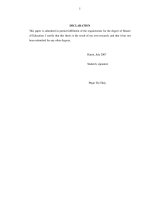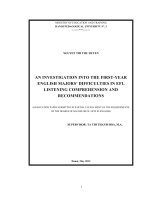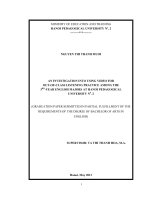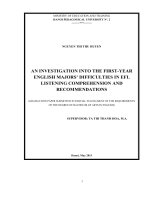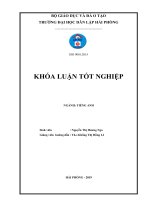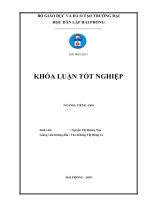An investigation into the current situation of using multimedia in learning listening skills of the first year english majors at vietnam national university of agriculture
Bạn đang xem bản rút gọn của tài liệu. Xem và tải ngay bản đầy đủ của tài liệu tại đây (616.2 KB, 76 trang )
VIET NAM NATIONAL UNIVERSITY OF AGRICULTURE
FACULTY OF EDUCATION AND FOREIGN LANGUAGES
BA THESIS
AN INVESTIGATION INTO THE CURRENT SITUATION
OF USING MULTIMEDIA IN LEARNING LISTENING
SKILLS OF THE FIRST-YEAR ENGLISH MAJORS AT
VIETNAM NATIONAL UNIVERSITY OF
AGRICULTURE
KHẢO SÁT THỰC TRẠNG SỬ DỤNG CÔNG NGHỆ ĐA
PHƯƠNG TIỆN TRONG HỌC KỸ NĂNG NGHE TIẾNG
ANH CỦA SINH VIÊN NĂM THỨ NHẤT NGÀNH NGÔN
NGỮ ANH TẠI HỌC VIỆN NÔNG NGHIỆP VIỆT NAM
Student:
TO THI THUONG
Student code:
621276
Major:
ENGLISH
Supervisor:
NGUYEN THI HUONG, M.A
Hanoi – 2021
CERTIFICATE OF ORIGINALITY
I, the undersigned, hereby certify my authority of the study project report entitled
"An investigation into the current situation of using multimedia in learning
listening skills of the first-year English majors at Vietnam National University of
Agriculture" submitted in partial fulfillment of the requirements for the degree of
Bachelor in English Language. Except where the reference is indicated, no other
person’s work has been used without due acknowledgement in the text of the thesis.
Hanoi, 2021
To Thi Thuong
Approved by
SUPERVISOR
(Signature and full name)
Date: ……………………
i
ABSTRACT
Listening comprehension plays an important role in the language teaching and
learning process. In an attempt to enhance first year English majors' listening
comprehension in English listening class at VNUA, this paper is practiced. The study
aims to find out the current situation of first-year English majors at VNUA in using
multimedia tools in learning English; then offer solutions to improve students'
listening comprehension. The author used questionnaire and interviews as the
principal sources of data. Analyze of these data indicated that the multimedia tools
really helped enhance students' listening comprehesion. The students were found to
have been attracted to the listening when the teachers used multimedia tools in
teaching. Based on the findings of this study, some pratical recommendations in
application of these tools for teaching listening skill were presented.
ii
TABLE OF CONTENTS
PART I: INTRODUCTION .................................................................................. 1
1. Rationale for the study ........................................................................................ 1
2. Aims and objectives of the study ........................................................................ 2
3. Research questions .............................................................................................. 2
4. Scope of the study ............................................................................................... 3
5. Significance of the study ..................................................................................... 3
6. Design of the study ............................................................................................. 4
PART II: DEVELOPMENT .................................................................................. 5
Chapter 1: LITERATURE REVIEW ................................................................... 5
1.1. REVIEW OF PREVIOUS STUDIES .............................................................. 5
1.1.1. Foreign research ........................................................................................... 5
1.1.2. Vietnamese research..................................................................................... 9
1.2. DEFINITIONS OF LISTENING ................................................................... 11
1.3. FACTORS AFFECTING STUDENTS' LISTENING COMPREHENSION12
1.3.1. The linguistic factors .................................................................................. 13
1.3.2. The non-linguistic factors .......................................................................... 14
1.4. DEFINITIONS OF MULTIMEDIA .............................................................. 15
1.5. THEORETICAL BASIS OF USING MULTIMEDIA TOOLS IN
LANGUAGE TEACHING ................................................................................... 17
1.5.1. Constructivism ........................................................................................... 17
1.5.2. Cognitive Psychology ................................................................................ 17
1.5.3. Krashen's Affective Filter Hypothesis ....................................................... 18
1.6. MULTIMEDIA TOOLS AND LANGUAGE TEACHING ......................... 20
1.6.1. Support for using multimedia tools in language teaching ......................... 20
1.6.2. Critiques of using multimedia tools in language teaching ......................... 22
iii
1.7. TEACHERS' ROLE AND STUDENTS' ROLE IN MULTIMEDIA
ENVIRONMENT ................................................................................................. 24
1.7.1. Teachers' role ............................................................................................. 24
1.7.2. Students' role .............................................................................................. 25
1.8. MULTIMEDIA AT VNUA ........................................................................... 26
1.9. SUMMARY ................................................................................................... 26
Chapter 2: METHODOLOGY ............................................................................ 28
2.1. RESEARCH GOVERNING ORIENTATION .............................................. 28
2.1.1. Research question(s) .................................................................................. 28
2.1.2. Research types:........................................................................................... 28
2.1.3. Data analysis method ................................................................................. 29
2.2. RESEARCH METHODS .............................................................................. 29
2.3. RESEARCH SETTING/CONTEXT ............................................................. 30
2.4. DATA COLLECTING PROCEDURES ....................................................... 31
2.5. SUMMARY ................................................................................................... 32
Chapter 3: FINDINGS AND DISCUSSION ...................................................... 33
3.1. STUDENT'S REAL SITUATIONS OF LEARNING ENGLISH
LISTENING SKILL. ............................................................................................ 33
3.2. FINDINGS OF A QUESTIONNAIRE SURVEY......................................... 33
3.3. FINDINGS FROM INTERVEWS ................................................................ 46
3.4. DISCUSSION OF FINDINGS ...................................................................... 49
3.5. SUMMARY ................................................................................................... 51
PART 3: CONCLUSION ..................................................................................... 52
1. Recapitulation ................................................................................................... 52
2. Concluding remarks .......................................................................................... 53
3. Limitation of the current research ..................................................................... 54
iv
4. Recommendations for using multimedia tools in teaching listening effectively
............................................................................................................................... 55
5. Suggestions for further study ............................................................................ 59
REFERENCES ...................................................................................................... 60
APPENDIX 1 ......................................................................................................... 66
APPENDIX 2 ......................................................................................................... 70
v
PART I: INTRODUCTION
1. Rationale for the study
As an international language, English plays a vital role in the modern society.
It is needed for all areas in life. In Viet Nam, English has been taught from primary
school to higher education levels in recent years. It is well known that listening
comprehension plays a key role in foreign language learning. Listening is one of the
skills that form the basis of one’s communicative competence.
Vietnam National University of Agriculture (VNUA) is a multidisciplinary
training school, a key national university. The English training program for students
is one of the key and long-term strategies of VNUA. In the training program of
VNUA, English is compulsory for each student.
The first-year English major students are between the ages of eighteen and
nineteen. They have learnt English for many years at secondary and high school.
However, they mainly focused on grammar and writing but not listening. They seem
to feel unfamiliar with listening lessons and many students say that they feel difficult
when doing the listening test on the computer. They only study listening in the class
with the CD player and text and say listening is boring and hard to study. As a student
in this school, the author questioned herself whether using multimedia tools will
motivate the students in learning listening as well as improve their listening skills.
At VNUA, teachers use the textbook Starting Skills to teach English to English
major students. Usually, teachers would come to class, play the CDs and students
would listen and do the listening tasks in this book with no additional activities and
exercises. Therefore, listening lessons are usually boring and students do not like
these lessons.
1
Nowadays, information technology is developing faster and faster so the use
of multimedia technology in learning English has many advantages. For example,
Gilakjani (2012) argues that "The use of multimedia in teaching and learning leads
to higher learning ..." Healey et al (2008) also assert that the use of technology for
teaching and learning is moving their institution in the right direction.
For all these reasons, the author would like to do the research on investigating
the current situation and suggested solutions of VNUA first-year English majors'
multimedia-based learning listening skills.
2. Aims and objectives of the study
2.1. Aims
The main aim of this study is to investigate the current situation of using multimedia
in learning listening skills of VNUA first-year English majors.
2.2. Objectives
The overall purpose of this survey is to investigate the following issues:
• Investigate the current situation of using multimedia in learning listening skills
of VNUA first-year English majors.
• Propose some solutions to improve students' using multimedia in learning
listening comprehension skills.
3. Research questions
This study is conducted to seek the answer to the following research questions:
a. What is the current situation of using multimedia in learning listening skills of
VNUA first-year English majors?
b. What are some solutions to improve students' using multimedia in learning
listening comprehension skills?
2
4. Scope of the study
- Research subjects: the first-year English majors at Vietnam National University of
Agriculture.
The total numbers of the first-year English majors: 139 Students
• K65ENGA: 34 students
• K65ENGB: 25 students
• K65ENGC: 33 students
• K65ENGD: 29 students
• K65ENGE: 18 students
- Research objects: Using multimedia in learning listening skills of first-year English
majors at VNUA
- Time: From January 2021 to July 2021.
However, because the number of participants and time are limited, this study
can not cover the whole issue of listening skill. Moreover, the study could not touch
upon all the students at VNUA. It is confined to the first-year students in English
majors at VNUA only.
5. Significance of the study
This project will focus on researching and learning about multimedia-based
learning listening skills. The researcher tries to find out the effectiveness of using
multimedia tools in learning listening and through which learners will gain a deeper
understanding of the meaning of using multimedia in learning listening skills, and
how to use efficiently and improve students' listening comprehension.
3
6. Design of the study
Apart from abstracts, references & appendices, the study consists of three main
parts:
PART 1: INTRODUCTION, presents rationale of the study, aims and
objectives of the study, research questions, the scope as well as the significance of
the study.
PART 2: DEVELOPMENT is divided into 3 chapters:
• Chapter 1: LITERATURE REVIEW, provides theoretical background for the
study including definitions of listening as well as multimedia tools. The
difficulties of learning listening are provided in this chapter. The author also
shows the relationship between multimedia tools and learning listening, the
roles of teachers and students in multimedia environment. Many previous
foreign and Vietnamese studies are included in this chapter.
• Chapter 2: METHODOLOGY, describes the methodology used in the
research including the research governing orientation, data collection
instruments, participants, the procedures employed to carry out the research.
• Chapter 3: FINDINGS AND DISCUSSIONS, reports and discusses the
findings of the study.
PART 3: CONCLUSION, summarizes the research and states the conclusion, the
limitations of the study as well as the suggestions for further study.
4
PART II: DEVELOPMENT
Chapter 1: LITERATURE REVIEW
In this chapter, the author addresses issues relating to listening, multimedia
tools, and the application of multimedia tools in language teaching. There are nine
sections in this chapter. The first section is the previous research about the
application of multimedia tools in language teaching and learning in foreign
countries as well as in Vietnam. The second section is to examine different views on
the definitions of listening; the factors affecting students' listening comprehension
are mentioned in the third section. In the fourth section, the definitions of multimedia
are presented. Theoretical basis of using multimedia tools in language teaching is
described in the fifth section. The author provides many ideas about applying
multimedia tools in language teaching in the next section. The seventh section is
designed to look at the teachers' role and students' role in multimedia environment.
The use of multimedia at VNUA is discussed in the eighth section. The chapter is
closed with summary.
1.1. REVIEW OF PREVIOUS STUDIES
Many studies about the application of multimedia tools have been conducted in
foreign countries as well as in Viet Nam
1.1.1. Foreign research
Smidt and Hegelheimer (2004) conducted a study to find the impact of webdelivered video and flexible listening strategy on students’ listening comprehension.
They gave the pre-test and post-test on vocabulary on a 15-minutes lecture about
horticulture to twenty-four ESL students from a listening course. The result showed
that the use of videotext and other visual materials like PowerPoint slides in a
listening course helped improve student's listening.
5
Yang and Fang (2008) presented some advantages and eight principles for
using multimedia tools in their study. They aimed to improve students' competence
in thinking and practicing using multimedia and the creation of context in optimizing
English-language teaching. According to the authors, there are several advantages to
employing multimedia to create a context in which to teach English. The researchers
explored the characteristics of multimedia and how to use multimedia to optimize
the context of English teaching. These authors also found that eight principles of
systematization
-
authenticity,
appropriateness,
interactivity,
coordination,
interactivity, coordination, pluralism, intelligibility, and penetrability - are used for
this purpose.
Shuell and Farber (2001) examined the attitudes of over 700 college students
towards the use of computer technology in twenty courses representing a wide range
of academic disciplines. Students were very positive about the use of technology in
their learning.
Joanna and Philip (1999) did a research at City University of Hong Kong
which evaluated the effectiveness of a multimedia-based English language learning
program. According to the findings, students who finished the curriculum in a
multimedia-enhanced manner improved their listening abilities significantly more
than students who completed the same syllabus in a traditional classroom mode. The
results also demonstrate positive attitudinal changes for the multimedia-enhanced
mode of learning. Additionally, the article elaborates on the teaching-learning
experience from the student and facilitator perspective.
In 2011, Dr. Hammadi conducted the research about "The effectiveness of
using multimedia software in developing some listening skills among Saudi
secondary school students". In order to measure the effectiveness of using
multimedia software in developing some listening skills, he prepared a pre-test and
6
a post-test at the beginning and at the end of the experiment to measure the students'
listening skills. The result of the pre-test shows that at the beginning of the
experiment there were no statistically significant differences between the mean
scores of the experimental and control groups. After using multimedia software in
teaching listening, the researcher gave two groups the post-test and compared the
differences between two groups. The result of post-test shows that there were
significant differences in the post-test mean scores of the experimental and control
groups on the total listening comprehension test in favor of the experimental group.
The improvement in the performance of the experimental group in the post-test
indicates the effectiveness of the proposed software.
Yang (2012) discussed the necessities, two theories and some advantages of
multimedia in his research about using multimedia in English teaching in vocational
colleges. In addition, he proposed four important principles of using multimedia for
English teachers. These four principles will greatly enhance the efficiency of English
teaching. According to Yang, using multimedia in English teaching brings some
advantages but the teachers must comply with four principles: multimedia only plays
an assistant role, teachers still play a leading role, students have the center position
and teaching should combine the traditional way and multimedia technology.
Amine, Benachaiba and Guemide (2012) implemented a case study about
using multimedia to motivate students in EFL classrooms with English graduate
students at a university in Algeria. They designed the questionnaire and administered
it to one hundred and twenty students pursuing a Master's degree at Med Seddik
Benyahia University, Algeria, in June 2012. The students were chosen from the same
field of English studies but were at two different levels: 1st year and 2nd year. The
students were divided into two levels: 1st-year Master's degree, with sixty students
(fifty five females and five males) and 2nd-year Master's degree, with sixty students
7
(fifty four females and six males). The questionnaire was composed of ten questions
about motivation and technology use in EFL classrooms. Most of the students
believed that using multimedia in EFL motivates them.
Sejdiu (2013) also found the impact of multimedia technology on developing
L2 listening skills. He determined that he the use of Computer-Assisted Language
Learning (CALL) was an effective means of developing and enhancing language
skills among L2 learners. Firstly, he emphasized the significant important roles of
listening in the acquisition of a language and then he gave many other researchers'
opinions on using multimedia in teaching listening skill. Many studies suggest that
multimedia-based instruction is necessarily better than traditional instruction with
respect to listening comprehension. At the end of his study, he presented that "L2
speakers, through multimedia, stand provided with access to various aural and visual
L2 texts via video, audio, blogs, podcasts, and the internet among others. Putting
multimedia into use in listening instrument, stands as a move towards assisting the
learners of L2 understand L2 within the daily context".
Pun (2013) presented some advantages and disadvantages when using
multimedia technology in language teaching. He said that if the teachers ignore the
technology, they will never catch up with the new trend. Teachers can create colorful
and stimulating classes when they use the multimedia technology. His study
indicated that using multimedia can motivate students to learn English, develop
students' communicative competence, widens students' knowledge about the culture
of English, improve teaching efficiency, enhance interaction among students and
between teachers and students, create a conducive teaching environment in the
classrooms and provide opportunities for English teaching outside the classrooms.
However, he also gave many disadvantages when using multimedia technology in
language teaching such as lack of communication between teachers and students,
8
lack of real time teaching, and lack of students' logical thinking. He suggested many
recommendations to improve these disadvantages.
Similarly, Nomass (2013) conducted a study about "The impact of using
technology in teaching English as-a Second language." She pointed out the role of
using technology in teaching English and with each skill she showed some technical
ways to improve the students' capability. With listening skill, teachers can use
computers, broadcasting, CD- players, and tape-recorders to support teaching.
1.1.2. Vietnamese research
Thao Vu Thi Phuong (2005) carried out an investigation into the application
of multimedia tools in supporting listening skill teaching and learning. This research
aims to investigate the effectiveness of multimedia tools in supporting listening skill
teaching and learning, particularly on the Term-3 listening course at English
department in Hanoi University of Foreign Studies (HUFS) and improving the
students' listening skills. Her study was conducted to answer three research
questions: (1) What are the teachers and students' attitudes towards the use of
multimedia tool in teaching and learning? (2) How does multimedia assist teacher's
jobs at class? and (3) Does multimedia language teaching support students' listening
comprehension better than video language teaching?
After doing the research, she found that the majority of teachers and students
believed that if they used multimedia tools, they would achieve an upward leveling
effect, improve students' language proficiency and make the acquisition process
easier, quicker and more interesting. She also found that the scores of students'
listening comprehension after using multimedia tools are better than the others.
However, she said that in many cases language teachers and learners have not yet
maximized their benefit for two main reasons. First, teachers and students lacked
adequate computer skills and familiarity with the tools, which slowed down and
9
obstructed the learning process. Second, the current teaching and learning styles of
trainers and learners also prevented the learning process from flowing. Therefore, in
order to carry out their teaching task successfully, language teachers need adequate
computer skills training as well as the access to the communicative teaching
approaches instead of traditional approaches.
Nhon Dang Thanh (2011) discussed the detail background, advantages and
disadvantages. of exploring CALL options in Vietnam. He said that the application
of computers and the Internet in EFL instruction in Vietnam is limited and embryonic
and he has proposed an appropriate response to the current situation by suggesting
some CALL options that allow Vietnamese EFL teachers with high, moderate, or
low computer proficiency to exploit the present technological resources to promote
their students' English-language learning. In this paper, the CALL options selected
and recommended are made mainly based on his perspective after reviewing
empirical studies.
Lan Luu Thi Phuong (2011) also conducted a study about "Adopting CALL
to Promote Listening Skills for EFL Learners in Vietnamese Universities". After
doing the research with four teachers of listening and their students (in total
approximately 100), she showed that there was a difference between the listening
scores of the students in the intervention classes compared to those of the control
group. The teachers showed changes in their attitudes towards computer use, and
gained better skills in selecting effective sources from the Internet for listening
instruction. The study suggests that computer use in listening instruction should be
given much more consideration so as to improve the listening skill of EFL learners,
and to motivate both teachers and learners.
10
1.2. DEFINITIONS OF LISTENING
Listening plays an important role in learning English. "Listening", as defined
by Purdy (1997), "is the active and dynamic process of attending, perceiving,
interpreting, remembering, and responding to the expressed (verbal and nonverbal),
needs, concerns and information offered by other human beings". Anderson and
Lynch defines that "listening comprehension means to understand what a speaker
says: the listener has a crucial part to play in the process by activating various types
of knowledge, by applying what he knows to what he hears and trying to understand
what the speaker means".
Rost (2002) defines listening as a process of receiving what the speaker
actually says, constructing and representing meaning, negotiating meaning,
negotiating meaning with the speaker and responding, and creating meaning through
involvement, imagination and empathy. To listen well, listeners must have the ability
to decode the message, the ability to apply a variety of strategies and interactive
processes to make meaning, and the ability to respond to what is said in a variety of
ways, depending on the purpose of the communication.
According to Buck (1995), "listening comprehension is an active process of
constructing meaning and this is done by applying knowledge to the incoming
sound." This definition gives a hint that listening is a hard skill that requires the
listeners to have the abilities of decoding the message, understanding speakers'
meaning in a variety of ways, and understanding the purpose of communication.
Saricoban (1999) states that listening is the process of identifying and
understanding the speech of the speakers. It involves understanding the speaker's
accent or pronunciation, speaker's grammar and vocabulary, and comprehension of
meaning., Listeners are required to implement four things at the same time and it is
not easy. It can be said that listening is very important in the process of second
11
language education. Saricoban (1999) also determines that listening can help people
acquire a large portion of their education, their information, their ideas, and their
understanding of the world. As an input skill, listening plays a vital role in student's
language development.
Nunan (1998) believes that "listening is the basic skill in language learning.
Without listening skill, learners will never learn to communicate effectively. In fact
over 50% of the time that students spend functioning in a foreign language will be
devoted to listening"
According to Poelmans (2003), listening comprehension is defined as the
ability to communicate effectively. It is important for the listener to understand what
the speaker is saying. Instead of a simple match between sounds and meaning,
understanding spoken language can be regarded as an inferential process based on
the perception of many cues. The listening comprehension process is a combination
of (roughly)four sub-processes or modules: (i) hearing: the auditory reception of an
acoustic signal (perception), as is also performed on non-speech sounds, (ii)
categorization of sounds: categorizing incoming sounds in terms of the sound
categories of the language (iii) word recognition: breaking up the stream of sounds
into linguistic units (morphemes, words) and retrieving their meaning from long term
memory, and (iv) comprehension: integrating the meanings of the words in their
sequence into an interpretation of the entire utterance, i.e., a reconstruction of the
speaker’s communicative intention.
1.3. FACTORS AFFECTING STUDENTS' LISTENING COMPREHENSION
There are many factors that create difficultly for students in learning listening.
Brown and Yule (1983) present that there are four main groups of factors which
cause the difficulty in listening comprehension. They are The speaker (including the
number of speakers, the speakers' speed, the speaker's accents); The listener
12
(including the role of listener, the level response required and the listener's interest
the subject); The content (vocabulary, grammar, information structure, background
knowledge); and The support (pictures, video, etc.).
Anderson and Lynch (1988) suggest that the factors that make listening
difficult include the type of language, the purpose in listening, and the context in
which listening takes place.
In conclusion, there are many elements that make listening challenging. The
list below ranges from linguistic factors to non-linguistic factors.
1.3.1. The linguistic factors
▪ Reduced forms
The term reduced forms refers to a phenomenon commonly observed in the
informal speech of native speakers. Celce-Murcia, Brinton, and Goodwin (1996)
explain that "these forms involve unstressed vowels, omitted sounds, and other
alternations of the full form, such as assimilation, contraction, and blending". For
example, in the sentence "I want him to study another language", the sounds of "him"
are reduced; accordingly, instead of /hIm/, "him" is pronounced as /Im/ or /schwa +
m/, It is clear that reduced form brings great difficulties for the students to listen.
▪ The number of speakers
The number of speakers also may bring difficulties for students. For example,
listening to a simple dialogue between two speakers will be easier than listening to a
dialogue with many speakers.
▪ Pronunciations, rhythm, and intonation
One of the factors that bring much difficulty for students while listening to
English is the way it is pronounced. There are many words stressed when people
speak, but there are also many words bearing no stress. Many students now do not
know how to pronounce many words so they cannot listen to these words when they
13
learn listening. The speed of speakers also causes difficulty for the students. That is
why many listeners cannot listen easily.
Other reasons which make listening challenging for the students are rhythm
and intonation. Many students are not used to the rhythm and intonation patterns of
the English language. According to Rixon (1986), the English system of intonation
and rhythm can interfere with the foreign learner's understanding of spoken English.
▪ The unfamiliarity of topic
The topic clearly affects the students in listening. It is easier for them to listen
to a passage or dialogue in a familiar topic such as daily life (shopping, sports, etc.)
than in an unfamiliar topic (such as economy, pharmacy, etc.).
▪ Speaker's accent
According to Harmer (1991), English is not one language, it is many
languages, or rather there are many varieties of English used all over the world. This
means that there are many English accents in the world. We can hear British English,
American English, Australia English, Indian English, etc., and even Vietnamese
English. So, English requires learners to understand as many accents as possible. It
is not surprising when students claim that they meet many difficulties with speaker's
accent. These difficulties increase since participants do not have much exposure to
the different English accents.
▪ Background noise
Noise is another reason that brings problems for students in listening. It makes
them fail to concentrate on the speaker or catch the listening ideas.
1.3.2. The non-linguistic factors
▪ Background knowledge
Background knowledge is believed to affect the success and failure of listening
comprehension. Brown and Yule (1983) state that "organized background
14
knowledge leads us to expect or predict aspects in our interpretation of discourse".
Rost (2002) believes that listening is a complex, active processes of interpretation in
which listeners match what they hear with what they already know.
Trao Nguyen Van (2002) refers background knowledge to "broad aspect: the
listener's background knowledge about culture where the language is used, the
knowledge about subject matter of the listening that he's going to hear about, the
familiarity with the topic, and his knowledge of every linguistic aspect of the
listening text".
Carrel and Eisterhold (1983) describe that background knowledge has two
kinds: content schemata and formal schemata. Content schemata consist of cultural
knowledge, topic familiarity and previous experience while formal schemata include
text types, theoretical conventions, and the structural organization of the text. They
believe that both content schemata and formal schemata can affect the listeners'
understanding.
It is clear that background knowledge is one of the key factors affecting the
understanding of a language.
▪ Other factors
Other factors here refer to some areas such as students' concentration,
prediction, and catching the listening ideas. Concentration is known as an essential
factor in doing anything. The students may listen to a familiar topic, but if they do
not concentrate, they will not hear anything.
1.4. DEFINITIONS OF MULTIMEDIA
Multimedia can be defined in many ways depending upon one's perspective.
"Multimedia is the exciting combination of computer hardware and software that
allows you to integrate video, animation, audio, graphics, and test resources to
develop effective presentations on an affordable desktop computer" (Fenrich, 1997).
15
Brinton (2001) believes that multimedia is "the seamless digital integration of text,
graphics, animation, audio, still images, and motion video in a way that provides
individual users with high levels of control and interaction".
According to Brauer (2001), multimedia is "a software tool that enables users
to branch or link text with video, audio, graphics, animations, or other digital data to
create multimedia presentations or products" and he further stated that "multimedia
authoring tools also facilitate important education cognitive processes, including:
cooperative learning, group problem solving, critical thinking, reflection, analysis,
inquiry, process writing, and public speaking. Multimedia authoring tools are
inherently metacognitive: they help students think about thinking".
The term medium can also refer to an input device such as a keyboard, mouse,
microphone, camera, or other sensor. Regarding computer input, multimedia then
refers to the capability of using multiple input devices to interact with a computer
system. (Blattner, Dannenberg, Multimedia Interface Design, p. xxiii).
Graham Davies (2011) refers to multimedia as "computer-based materials
designed to be used on a computer that can display and print text and high-quality
graphics, play pre- recorded audio and video material, and create new audio and
video recordings".
Maddux, Johnson and Willis (2001) state that "multimedia comprises a
computer program that includes text along with at least one of the following: audio
or sophisticated sound, music, video, photographs, 3-D graphics, animation, or
higher solution graphics."
According to Mayer (2001) “the term multimedia conjures up a variety of
meanings. You might think of sitting in a room where images are presented on one
or more screens and music or other sounds are presented during speakers- that is,
multi- media a “live” performance. Alternatively, you might think of sitting in front
16
of a computer screen that presents graphics on the screen along with spoken words
from the computer’s speakers- that is, multimedia an online lesson. Other
possibilities include watching a video on a television screen while listening to the
corresponding words, music, and sounds, or watching a PowerPoint”.
In conclusion, multimedia is an integration of many elements (audio, text,
video, animation, etc.) into one and this will bring more benefits than any one of
element provides individually.
1.5. THEORETICAL BASIS OF USING MULTIMEDIA TOOLS IN LANGUAGE
TEACHING
1.5.1. Constructivism
This term was introduced in early 1990s, which mentions the students' active
role in their learning. It is often discussed' from two perspectives, cognitive
constructivism and social constructivism. According to Fosnot (1996), knowledge
refers to restructuring and reorganizing the experience in cognitive constructivism.
Knowledge cannot be simply transmitted to the students but should be acquired
through students' experience and discovery. Social constructivism holds that learning
is the process of interacting and collaborating either among the students or between
the students and the teachers. Nunan (1999) states that constructivism encourages
students to learn through personal experiences rather than being fed by teachers. The
function of the education system is to create an environment in which students can
reconstruct their knowledge through relating their existing input with the new
knowledge. Leaning with multimedia tools can help this.
1.5.2. Cognitive Psychology
Cognition, or mental activity, involves the acquisition, storage, and use of
knowledge, and learning is not to acquire knowledge in a passive way but initiative
procedure of information acquisition depending on learners' attitudes, demands,
17
interests, habits, and their own backgrounds. From this statement, it can be concluded
that an individual is regarded as being an active and constructive being rather than
one who is a passive recipient of information, which is why multimedia language
teaching and learning is effective. Therefore, one of the most important roles of
teachers is to raise the students' interest and desire to learn. Multimedia tools with
the multimedia's integration of text, sound, animation, graphics and images to present
the learning content in a multi-dimensional way, can help teachers attract their
students in learning.
1.5.3. Krashen's Affective Filter Hypothesis
According to Krashen (1987) language acquisition is effected by four factors.
They include motivation, attitude, anxiety, and self-confidence.
▪ Motivation
No one can deny the position of motivation in language learning, but there is,
in fact, no agreement on the exact definition of motivation (Oxford & Shearin, 1994).
According to Dörnyei (1998), "although motivation' is a term frequently used in both
educational and research contexts, it is rather surprising how little agreement there is
in the literature with regard to the exact meaning of the concept". However, some
researchers and psychologists still give their own ideas about motivation.
Crump (1995) believes that excitement, interest, keenness, and enthusiasm
towards learning are the main constituents of motivation. The levels and kinds of
motivation in any individual are different from others. In other words, not only levels
and amounts of motivation in individuals are different, their kinds of motivation can
be also different. Lightbrown and Spada (2001) identify motivation in second
language acquisition as "a complex phenomenon which can be defined in terms of
two factors: learners' communicative needs and their attitudes towards the second
language community".
18
Motivation is known as an important factor that contributes to the success of
language learning and teaching in general and listening learning and teaching in
particular.
▪ Attitude
According to Krashen (1988), attitude is also an important factor that
influences the language learning. Students who have positive attitude in their
language learning tend to learn language actively, easily with a rapid process and can
have high grade.
▪ Anxiety
Gardner & MacIntyre (1993) considers language anxiety as "the apprehension
experienced when a situation requires the use of a second language with which the
individual is not fully proficient". There are three kinds of language anxiety in
language learning. They are communication apprehension, test anxiety, and fear of
negative evaluation. The feeling of fear when students communicate with another
person, have a test, or receive the negative evaluation from teachers will affect the
students' language learning.
▪ Self-confidence
One of the most important factors affecting the students' language learning is
self- confidence. It is believed that people who have enough self-confidence and
positive personal images will succeed more.
To sum up, learners will acquire the language effectively with high motivation,
positive attitude, confidence, and low anxiety. In contrast, learners with low
motivation, low confidence and high anxiety will not acquire the knowledge easily.
According to Warschauer (1997), "multimedia applied in teaching can create a
relaxing and non-threatening learning environment in which learners' motivation and
self-esteem can be promoted and learners' anxiety can be reduced".
19
